Arthur Tudor, Prince of Wales
Name and Titles: Arthur, Prince of Wales; Duke of Cornwall and Earl of Chester.
Born: 20 September 1486 at Winchester Castle, Hampshire.
Died: 2 April 1502 at Ludlow Castle, Shropshire.
Buried: His heart is buried in St Lawrence Church, Ludlow, Shropshire; His body is buried in Worcester Cathedral, Worcestershire.
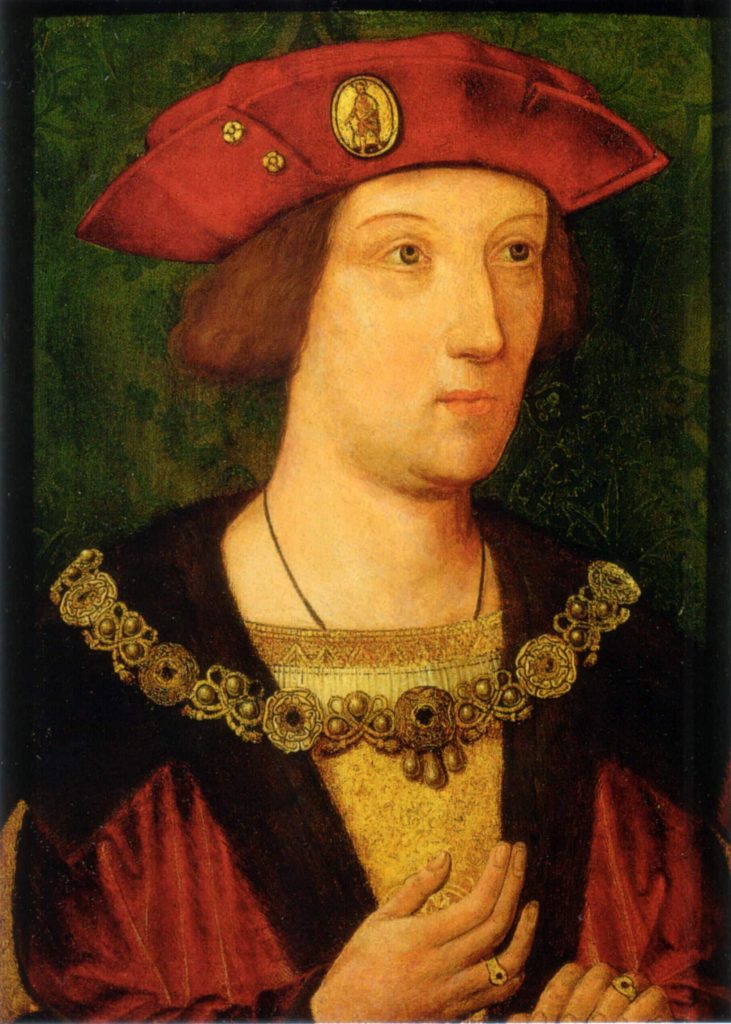
Arthur Tudor was born a little over a year after his father, Henry Tudor, won his crown at the Battle of Bosworth. The new king swiftly cemented an alliance with the House of York by marrying the eldest child of the late Yorkist King, Edward VI, and his Queen, Elizabeth Woodville. She was ‘Elizabeth of York’, and their marriage effectively brought to a close a bloody 30-year struggle for dominance between the Houses of Lancaster and York over the right to wear the English Crown.
The wedding of Henry VII and Elizabeth of York took place at Westminster on 18 January 1486. (By the way, it is unclear whether ‘this’ Westminster’ referred to the Palace of Westminster or the Abbey, although the latter is often cited.) Unless the new heir to the Tudor dynasty was born prematurely (which is possible), Arthur must have been conceived out of wedlock. He was delivered just eight months later at Winchester Castle, shortly after midnight on 20 September of the same year.
Winchester was no doubt strategically chosen by the new King to align the fledgling dynasty with the deep roots of England’s royalty, for Winchester had once been the Anglo-Saxon and, later, the early Norman capital of England. Its castle, built by William the Conqueror, was initially the Norman king’s centre of government. It endured as one of the most significant castles in the land for around 100 years after the conquest of 1066. Furthermore, according to the 15th-century author, Sir Thomas Malory, who wrote Le Morte D’Arthur, Winchester was also the fabled site of Camelot, a mythical kingdom enshrouded in the mystique of chivalry and monarchy – everything that Henry VII wanted the people of England to associate with him, his son and heir, and with the new Tudor dynasty. Indeed, the Tudors were to bring a golden age to England and its people!
When Arthur was three years old, he was created a Knight of the Garter and invested as the new Prince of Wales. Plans for his marriage to one of the daughters of King Ferdinand of Aragon and Queen Isabella of Castille had been ongoing for some years before their youngest daughter, Catherine of Aragon, was chosen as Arthur’s bride-to-be.
The formal betrothal of the young couple took place at the Palace of Woodstock in August 1497 before the proxy wedding ceremony was conducted in the private chapel at Tickenhill Palace, Bewdley, on 19 May 1499.
After many delays, Arthur’s Spanish Princess finally arrived on English shores on 2 October 1501. Following her progress to London, where she made her formal entry into the City, the couple were married at the Old St Paul’s Cathedral on 14 November of the same year.
Several weeks of celebrations followed, but shortly thereafter, the new Prince and Princess of Wales relocated to Ludlow Castle, where Arthur had spent much of his youth practising the art of kingship as Head of the Council of the Marches. This tradition harked back to the days of Edward IV, who had his two eldest sons, Edward, Prince of Wales and Richard, Duke of York, brought up in the same fashion.
Although by all accounts, the young prince was previously healthy, tragedy struck the Tudor dynasty when both Catherine and Arthur fell ill just four months later, possibly of The Sweat. Catherine was gravely ill but recovered. However, Arthur succumbed to the illness on 2 April 1502. His parents received the grievous news at Greenwich Palace just two days later, on 4 April, and were devastated in their grief. Elizabeth’s desire to shore up the dynasty following this loss would eventually lead to her death, following childbirth, in February 1503.
After Arthur’s body was cered, his heart was buried in the nearby parish church of St. Lawrence, while his body was conveyed to Worcester Cathedral for burial. Today, a divine chantry chapel with an exquisitely carved tomb chest marks the site of Arthur’s burial to the south of the high altar. Neither of Arthur’s parents was present, and apparently, Catherine remained too ill to attend.
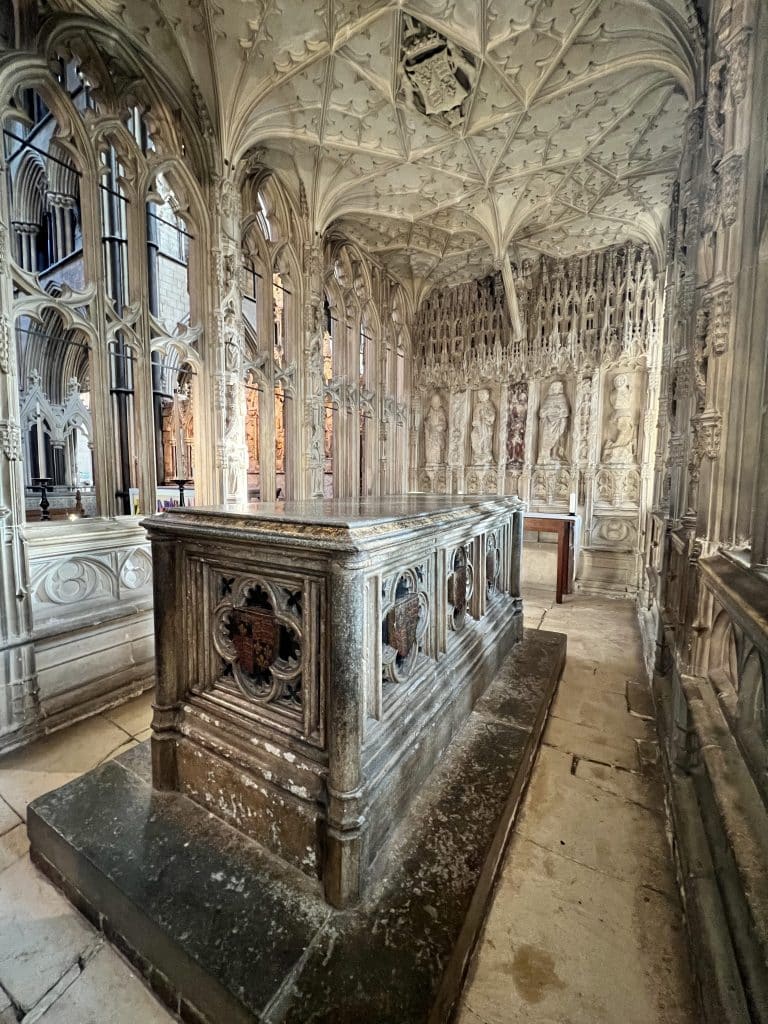
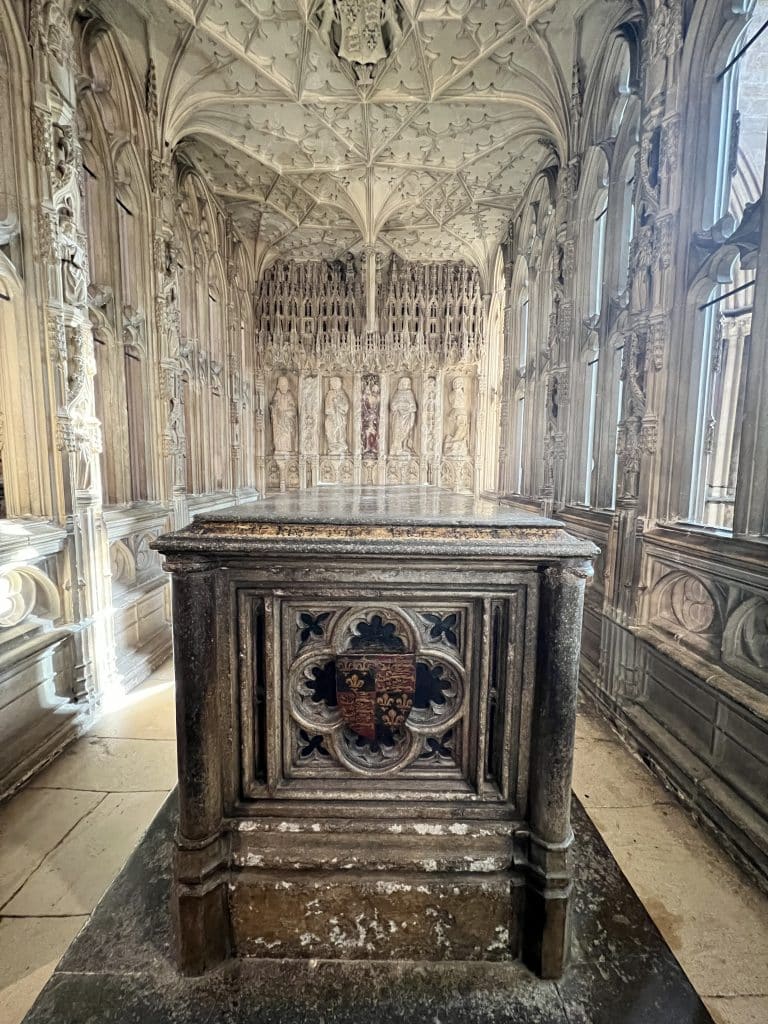
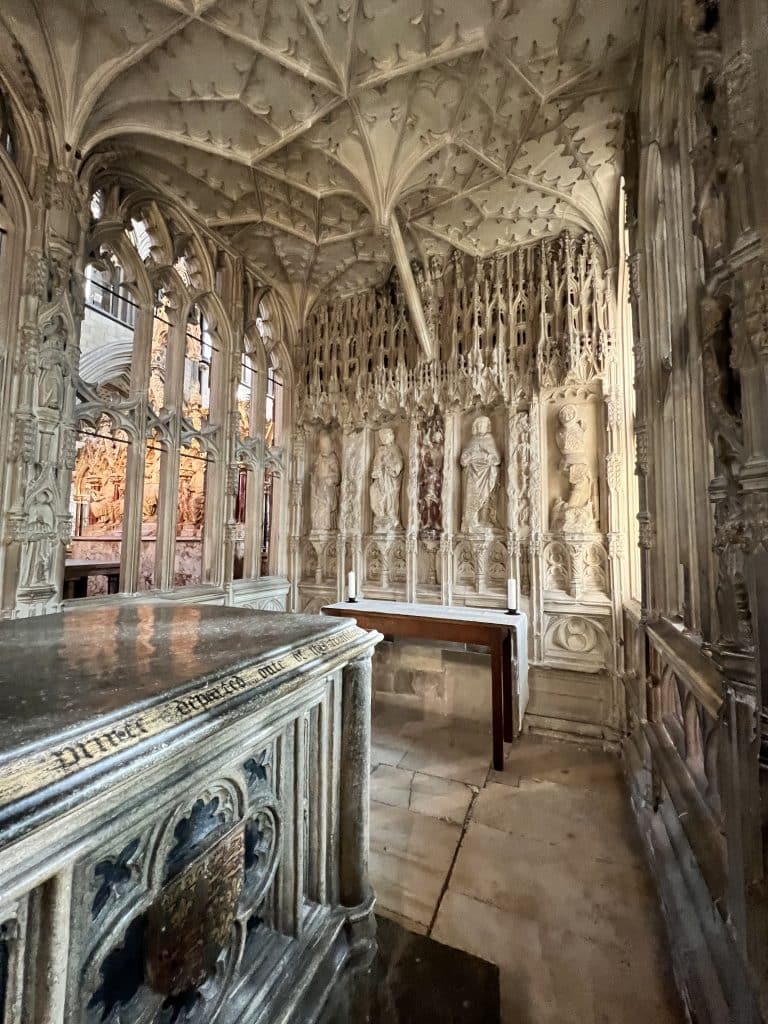
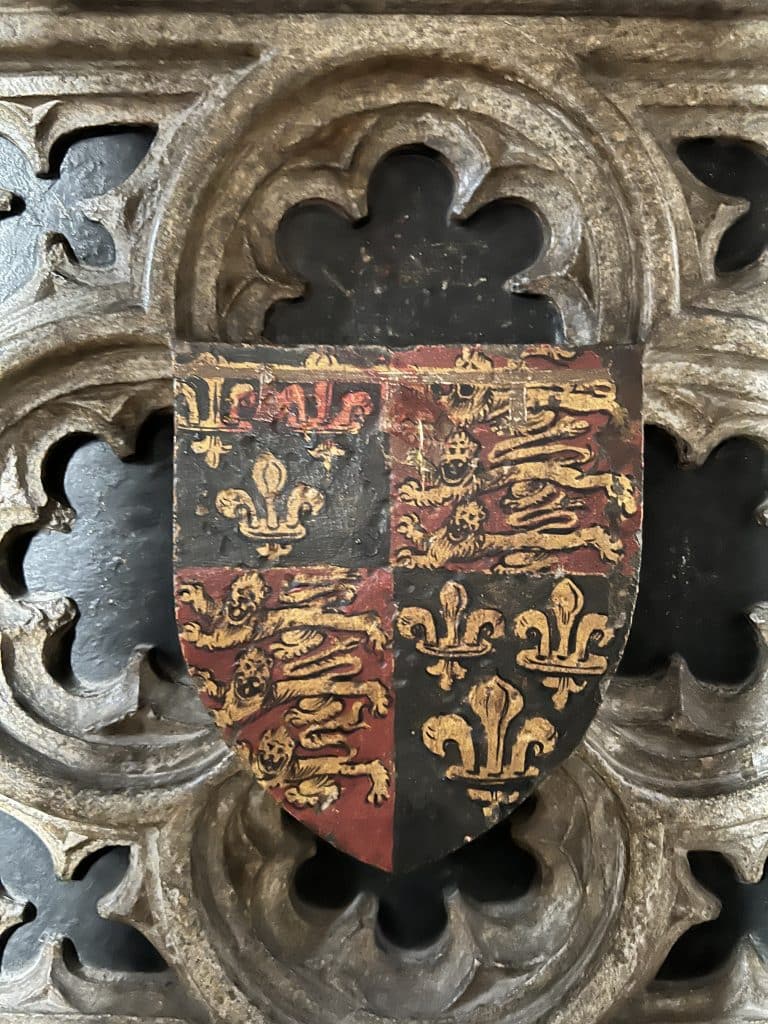
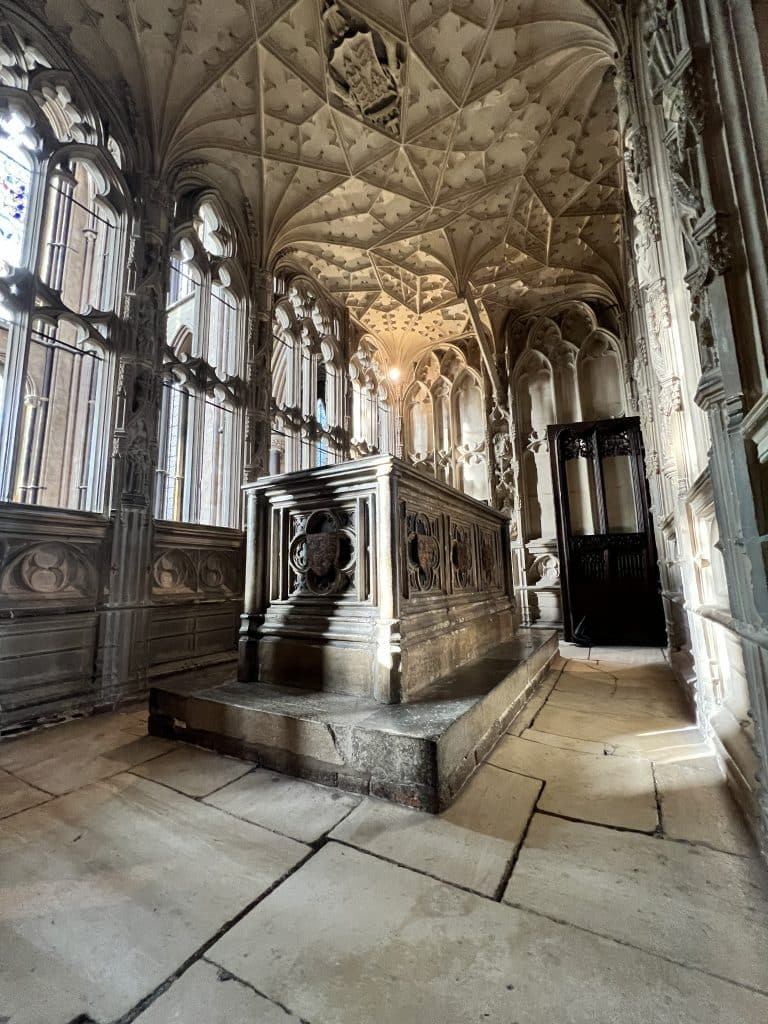
The Tomb
Prince Arthur’s tomb and chantry chapel lie south of the high altar in Worcester Cathedral. A contemporary record states 6s 8d were…
paid by the lord suffrage for the sanctification of the altar of Prince Arthur this year
The year in question was 1516/7. This means the final chapel was sanctified 14 years after Arthur died at Ludlow Castle.
To the untrained eye, Arthur’s tomb is perfect: a glorious symphony of late medieval architecture and full of Tudor heraldry. However, you might be surprised to hear that, in fact, it is a complete botch job! It seems that the dimensions of the intended design, probably carved and constructed piecemeal in the mason’s yard, did not account for certain architectural features in the cathedral. This meant that when it was time to assemble the tomb in its current position, south of the altar, horror or horrors, it didn’t fit! As a result, a bit of fancy footwork was required to reduce the width of the chapel.
To those in the know, with an eye to architectural symmetry, one of the most tell-tale signs of these last-minute changes is the central figure of the Man of Sorrows, carved into the reredos behind the altar. His proportions are narrow and have clearly been squeezed in to fit a much smaller alcove than initially intended. (If you are interested in knowing more about the other features which give away this monumental Tudor error, you might want to get your hands on a paper by Christine Buckley called Prince Arthur’s Chantry Chapel, Worcester Cathedral: Keeping Things In Proportion.)
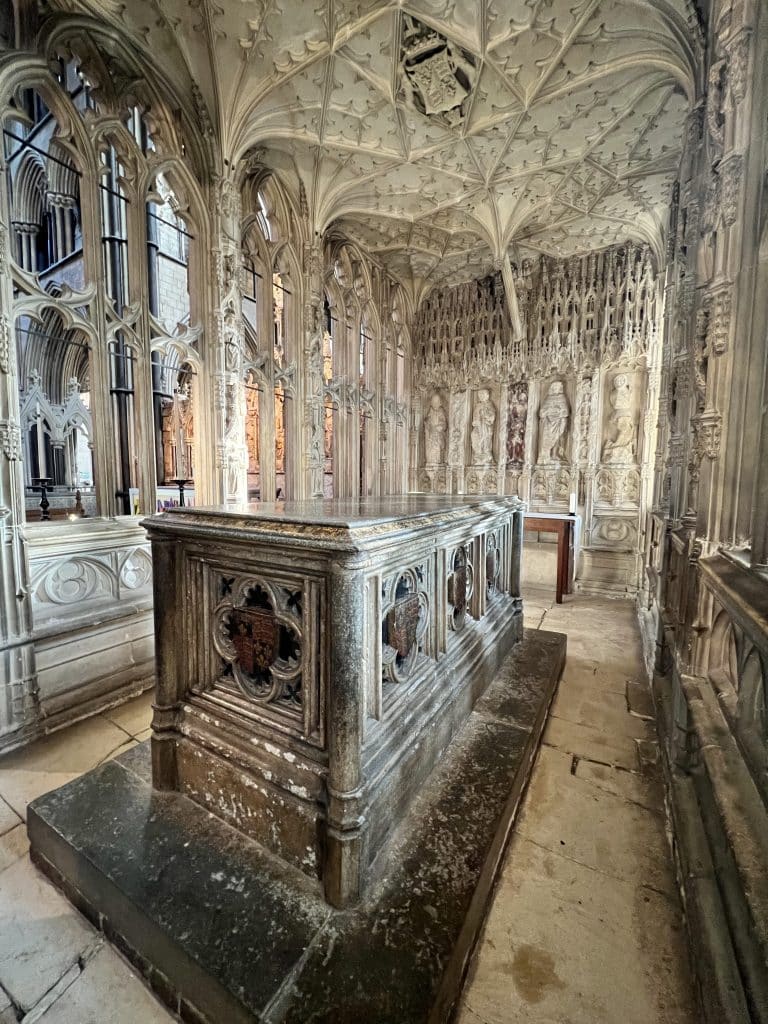
Although Arthur’s chantry chapel lies to the south of the high altar, where contemporary accounts record his body was laid to rest, interestingly, the exact location of his corpse is unknown. It is easy to surmise that the body might be in its box tomb (which is the case for King John, whose tomb lies nearby) or perhaps directly beneath it. However, it is unclear whether either of these is the case. Intriguingly, back in 2011, an archaeological survey of the area using ground-penetrating radar showed a large underground chamber off to one side of the chantry chapel. The question that people have wrestled with ever since is, ‘Is this the burial vault of the young prince?’
The chamber is large: 12 ft by nearly 6ft. According to Christine Buckley, this would ordinarily be large enough to accommodate four coffins. So, who else might lie within? It has been hypothesised that the chamber was also intended as a final resting place for Catherine of Aragon, who was eventually buried at Peterborough Cathedral. Interestingly, one of the other mysteries about Arthur’s tomb and chantry chapel is that it seems to have been built in the same place as the tomb of an early medieval bishop of Worcester: Bishops Gifford and de Constantiis. Some have conjectured that Arthur’s tomb chantry chapel may have recycled an existing chapel dedicated to this late thirteenth-century bishop. Thus, Buckley hypothesises that the unopened vault might also contain the bodies of Bishop Giffard and John de Constantiis, both recorded as having been buried in this cathedral area in the preceding centuries.
Given Arthur’s precipitous and unexpected demise, it is hard to imagine that the powers that be had time to construct a large underground vault ready to receive Arthur’s coffin in just three weeks – but perhaps this was entirely achievable given the right level of labour. However, maybe it was already in place and holding the bodies of the two men mentioned above. Despite this uncertainty, the fact remains that this chamber exists, and no one knows what lies within.
Unfortunately, to add to the confusion, no records survive that describe the commissioning or building of the tomb or the extent to which Arthur’s parents were involved in its design. However, one thing is certain: whoever constructed the chantry chapel was a master craftsman. It is exquisite. Furthermore, the interior and exterior are covered in heraldry and symbols of the Tudor dynasty. From the royal coat of arms at one end of the tomb chest (shown in the picture above) to the 19 carved stone panels on the exterior face of the south side of the chantry chapel, Arthur’s royal lineage and his noble descent from the Houses of Lancaster and York are emblazoned for all to see.
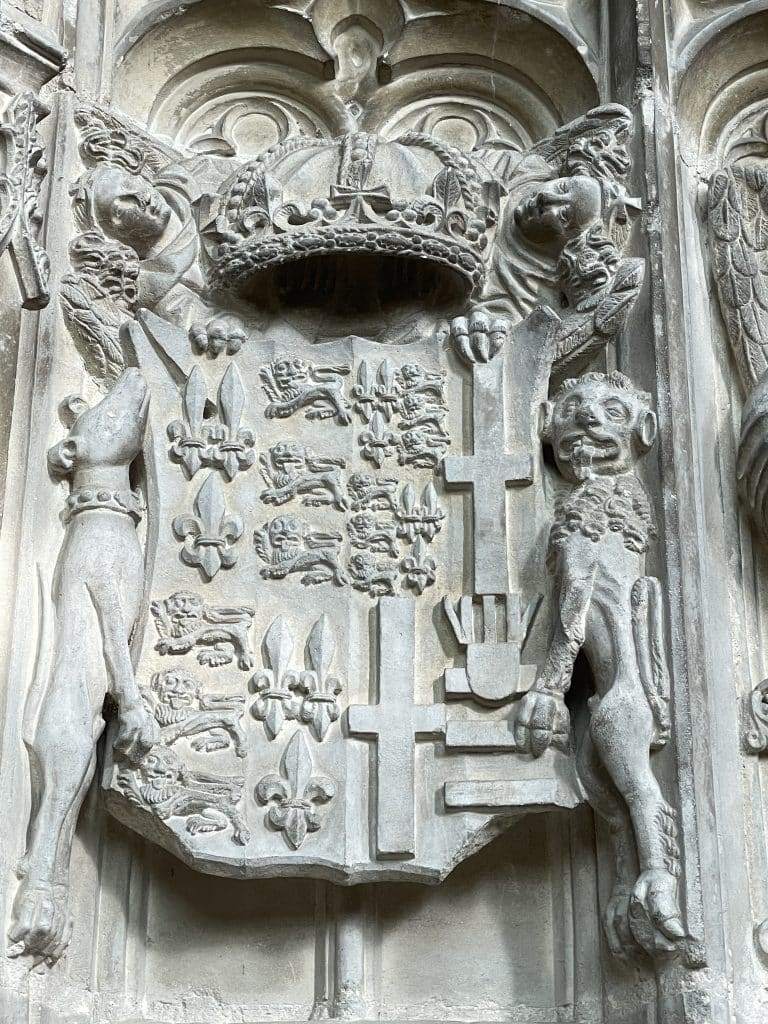
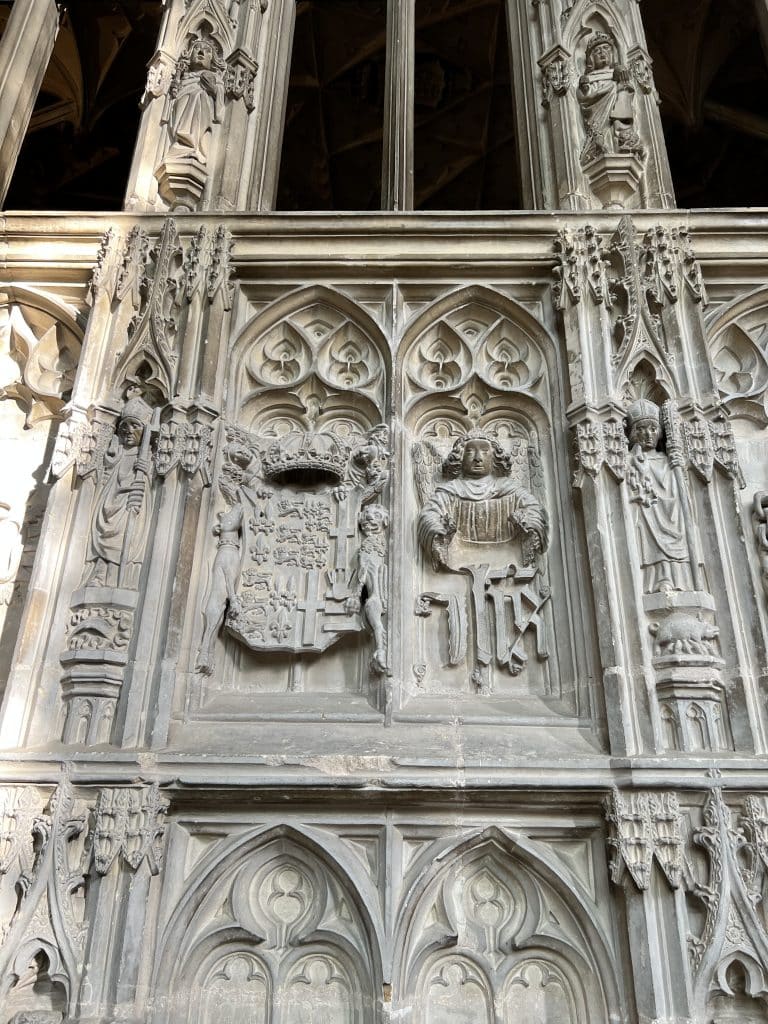
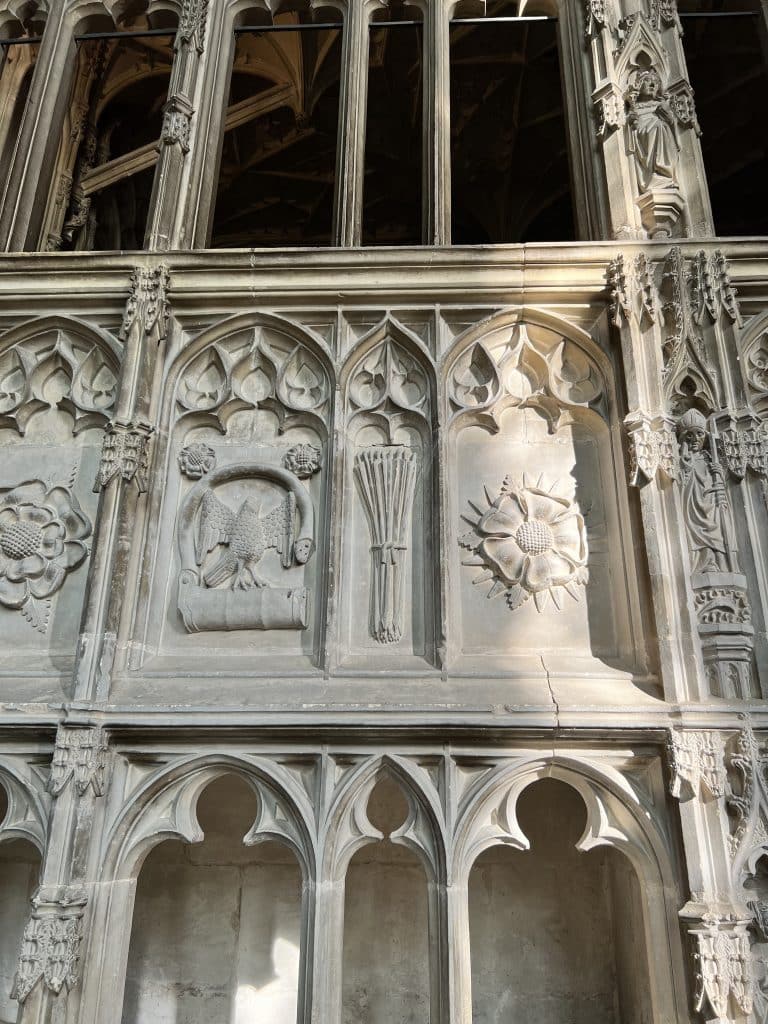
Included on those 19 panels are the ostrich feathers of the Prince of Wales, the Beaufort Portcullis, a single Tudor rose, the rose en soleil and the eagle and fetterlock (previously a Yorkist badge adopted by Henry VII). You might also want to see if you can spot the pomegranate of Granada (for Arthur’s wife, Katherine of Aragon), the arrows in a cluster (for Katherine’s father, Ferdinand of Aragon) and the fleur-de-lis (for Prince Arthur’s great-grandmother, Katherine de Valois and France).
Visitor Information:
Arthur’s chantry chapel lies at the heart of Worcester Cathedral, close to the high altar. While access to many chantry chapels around the country is prohibited, delightfully, the door to Arthur’s final resting place is open, allowing you to explore inside. Take note of the stone step at the threshold, satisfyingly worn away by centuries of visitors; these include Elizabeth I, who came to Worcester Cathedral during her summer progress of 1575 and viewed the tomb of her long-dead uncle.
Make sure you linger to enjoy the exceptional carving and symbolism surrounding you in this tiny space. I wager that you will also ponder the agonising question of ‘Just how different would history have been if Arthur had lived!’
After exploring the chapel’s interior, make sure you head to the south aisle to do a bit of heraldry spotting and identify all the heraldic badges described above.
While you are there, turn around to find another chest tomb in the centre of the south transept. This is the tomb of Griffith ap Rhys, fashioned from Purbeck marble. Griffith was a powerful Welsh knight who was born circa 1470. He rode at the head of Prince Arthur’s funeral procession in 1502 and would later continue to serve at court, including attending Henry VIII at the ‘Field of Cloth of Gold’. He died shortly thereafter, in 1521, aged 51.
Other Nearby Tudor Places:
- Worcester Cathedral: Be sure not to miss several other interesting Tudor tombs of wealthy local merchants and the cathedral cloisters. You can also book a tour of the Tower and the cathedral’s library. Check out the cathedral’s website to find out what tours are available and when.
- The Tudor House: (0.3 miles). The Tudor House is a small but perfectly formed independent museum, set in a fine example of a close-studded timber-framed building with the only remaining original embossed ceiling in Worcester. It was built in 1520, although its foundations are medieval.
- The Commandery: (0.2 miles). Although a museum dedicated to the history of the Civil War, in which Worcester played a significant role, the building itself is medieval. Thus, it will be of interest to any history lover. There is also a fine cafe on site – always a good excuse for a visit to a heritage property!
Other Articles & Books of Interest:
“They Buried Him at Worcester”: Heritage Sites, Historical Fiction, and a Local Look at Wolf Hall by History Workshop. 2020.
Arthur Tudor, Prince of Wales: Life, Death and Commemoration, Edited by Steven Gunn and Linda Monckton. Boydell Press. 2009.

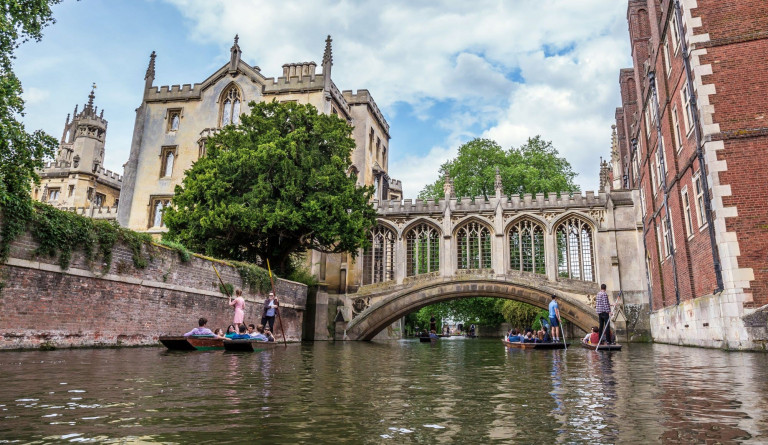
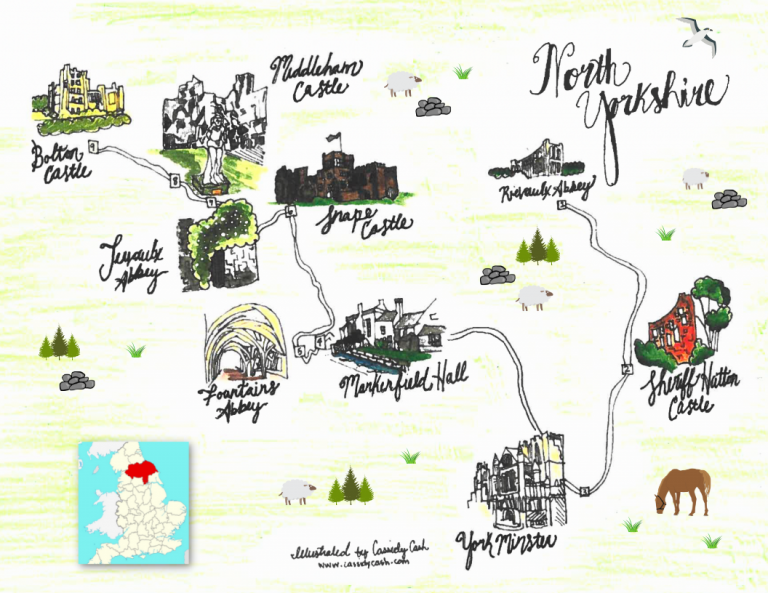
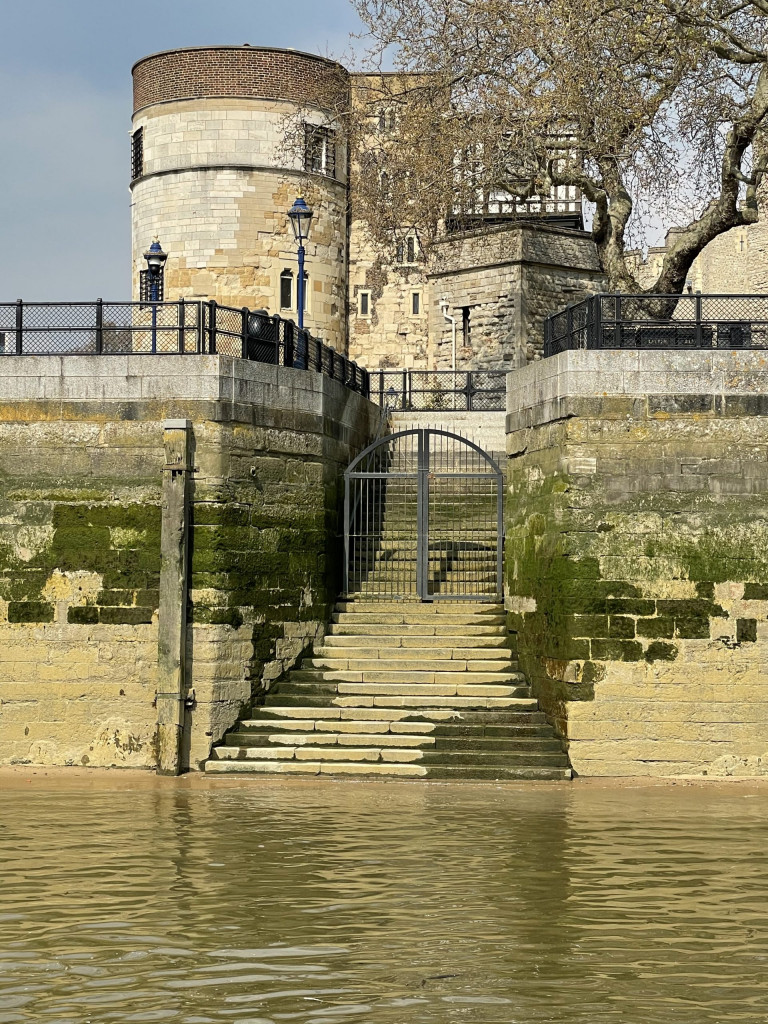
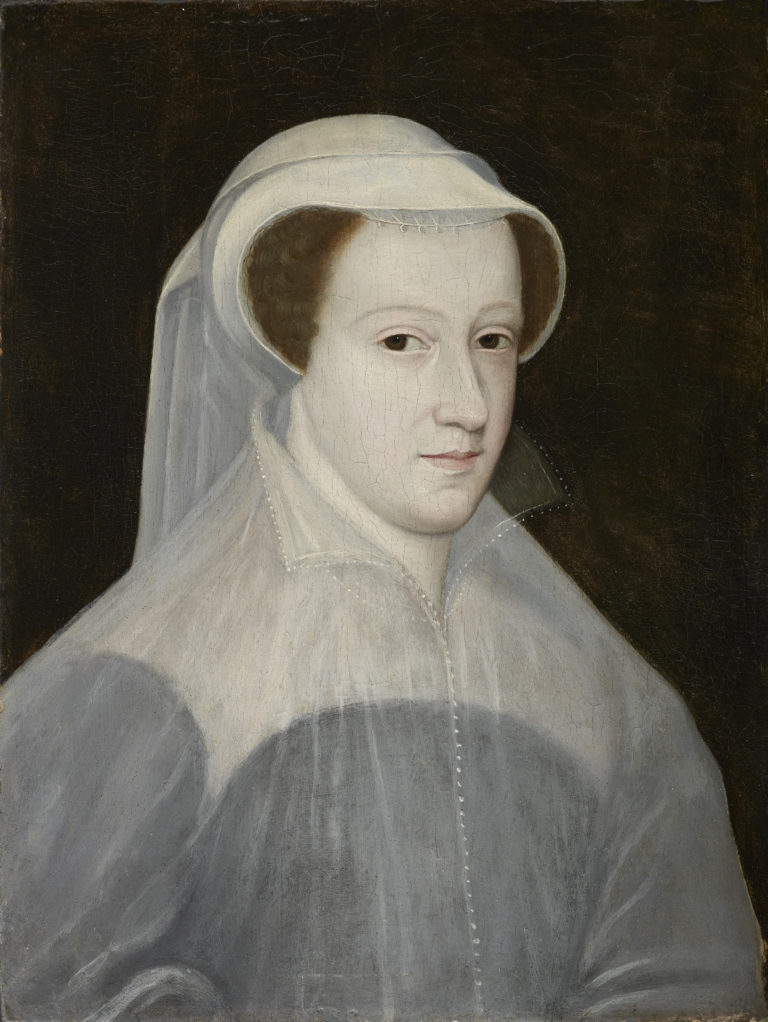

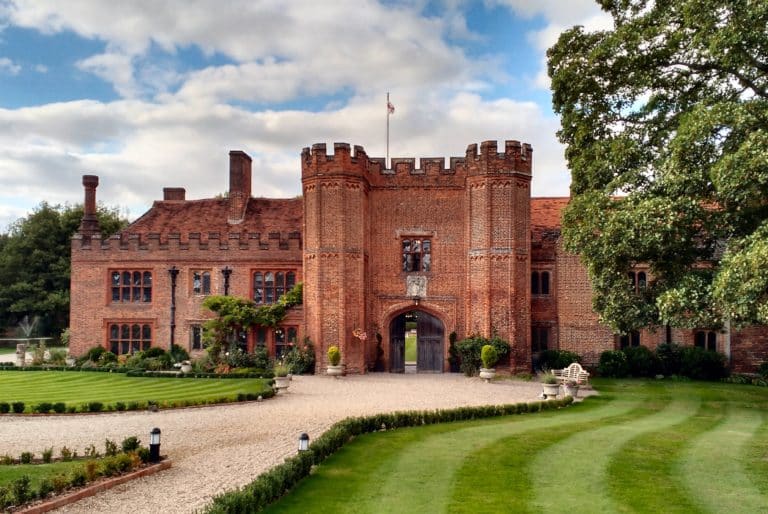
fantastic article and nicely detailed – helps me on my own quest of Arthur name as a lot of my relatives were associated with Worcester. Arthur is a prominent name that carried on from my grandfather down to my dad and my brother. thank you for writing this piece.
Thanks!
Nice to see this, but – is Thomas Malory’s name spelled differently in the UK? I’ve never heard or seen Morley – although I read all of Le Morte d’Arthur way back as an English lit major in the 1960s.
No not different. I think at some point my spellchecker decided ‘Morley’ was more appropriate and I failed to spot the change. Thanks for pointing that out. I have corrected the error.
Loved reading this and thank you ??
wonderful! Thanks for letting me know.